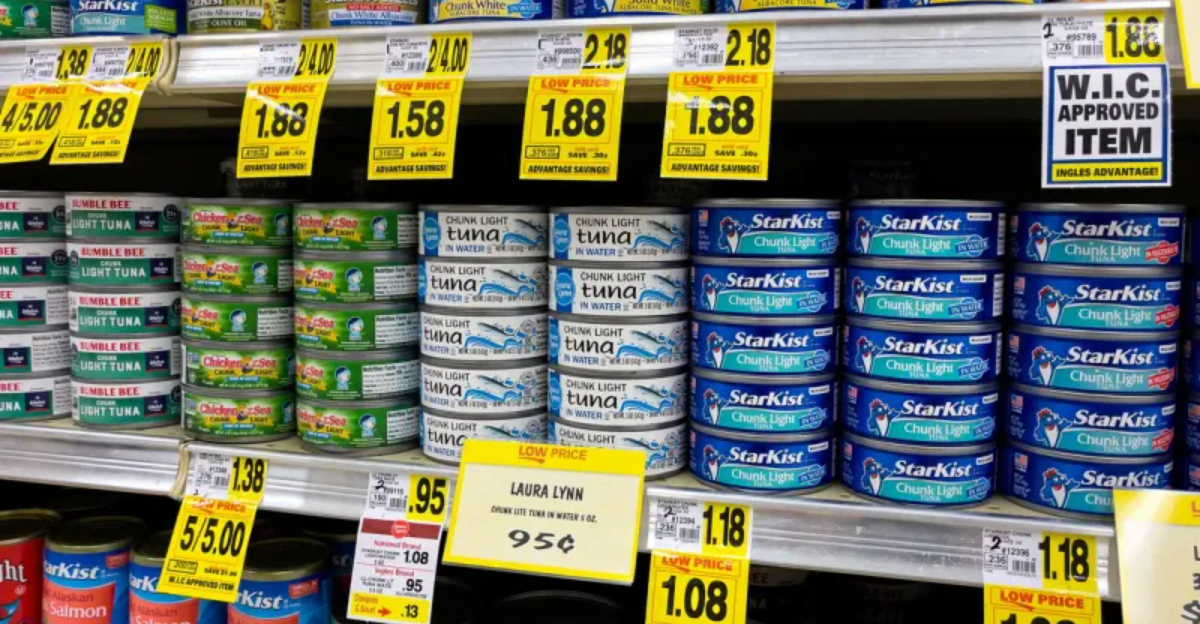10 Key Things To Check Before Buying Canned Tuna

Canned tuna might seem like a no-brainer at the store, but not all tins are created equal.
Between confusing labels, sneaky ingredients, and surprising differences in quality, picking the right can requires a little know-how.
Whether you’re tossing it in a salad, sandwich, or pasta, your tuna deserves better than mystery meat from the back of the shelf.
A few smart checks can help you reel in a tastier, healthier catch every time.
1. Expiration Date Matters More Than You Think
Fresh canned tuna tastes worlds better than old stock. While canned goods have impressive shelf lives, tuna’s flavor and texture degrade over time.
Always check that little stamped date, especially when stores are running sales. Sometimes those bargain bins contain products nearing their end dates.
For optimal taste, try to use your tuna within a year of purchase, even if the expiration date is further out.
2. Inspect That Can For Damage
Dents, rust spots, and bulges aren’t just cosmetic issues – they’re potential health hazards. Even small dents along seams can compromise the can’s seal, allowing bacteria to enter.
Bulging cans indicate possible bacterial growth inside, which could lead to botulism – a serious form of food poisoning.
Rusty cans might have tiny holes you can’t see. Always choose pristine cans with intact seals and smooth surfaces.
3. Look For BPA-Free Lining
Turn that can around and look for “BPA-Free” on the label. BPA (Bisphenol A) is a chemical used in some can linings that research suggests may disrupt hormones in the body.
Many brands have moved away from BPA, but not all. The white lining inside the can creates a barrier between metal and food.
Health-conscious consumers increasingly demand BPA-free options, pushing more companies to adopt safer alternatives for their packaging.
4. Which Fish Is Actually In There?
Surprise! “Tuna” isn’t just one fish. Your can might contain skipjack, yellowfin, albacore, or bluefin – each with different flavors, textures, and mercury levels.
Albacore (white tuna) offers a milder flavor but typically contains more mercury than skipjack (usually labeled “light tuna”).
Yellowfin provides a middle ground between the two. The species impacts everything from taste to nutrition, so check which swimming friend you’re actually bringing home.
5. Where In The World Was It Caught?
Tuna swim in oceans worldwide, but fishing practices vary dramatically by country. Some regions have stricter regulations about sustainable fishing methods than others.
American, Canadian, and European brands often follow more rigorous sustainability guidelines. However, this isn’t a hard rule.
Look for specific information about fishing location and methods on the label or the company’s website if you’re concerned about ocean health.
6. Water Or Oil? Your Choice Matters
Flip that can over and check whether your tuna is packed in water, oil, or something fancier like olive oil or broth. This choice affects more than just calories.
Water-packed tuna contains fewer calories and retains more omega-3 fatty acids. Oil-packed varieties offer richer flavor and smoother texture.
Some gourmet brands use olive oil or add herbs and spices. Your recipe plans should guide this decision – water for lighter dishes, oil for more decadent ones.
7. Salt Content Can Be Shockingly High
A single serving of some canned tunas packs nearly 30% of your daily sodium recommendation! This hidden salt bomb lurks especially in flavored varieties.
For those watching blood pressure or heart health, low-sodium options make a smarter choice. Check the nutrition panel for sodium content per serving.
Some brands offer “no salt added” versions that let you control seasoning yourself. Your body will thank you for this small label-reading effort.
8. Mercury Warnings Worth Heeding
Mercury naturally accumulates in tuna, especially larger species like albacore. While levels in commercial tuna are generally considered safe for most adults, they warrant attention.
Pregnant women, nursing mothers, and young children should limit consumption of white (albacore) tuna.
The FDA recommends these groups stick primarily to light tuna (usually skipjack), which typically contains three times less mercury.
Check for any advisory notes on packaging, especially for premium or large-species products.
9. Sustainability Certifications Tell The Truth
Logos from the Marine Stewardship Council (MSC) or the dolphin-safe label aren’t just marketing gimmicks.
These certifications indicate your tuna was caught using methods that minimize harm to marine ecosystems.
Sustainable fishing helps ensure we’ll have tuna for generations to come. The blue MSC label guarantees the fishery meets international standards for sustainable fishing.
Some brands also provide tracking codes you can enter online to see exactly where your specific tuna was caught.
10. Weight Watchers: Check The Drained Content
Net weight includes both tuna and its packing liquid, but what really matters is the drained weight. Some cans might seem like a bargain until you realize you’re paying for extra water or oil.
Look for “drained weight” on the label to know how much actual fish you’re getting. Premium brands often pack more tuna and less liquid.
This matters especially when comparing prices across brands – that cheaper option might actually contain less fish per can!
